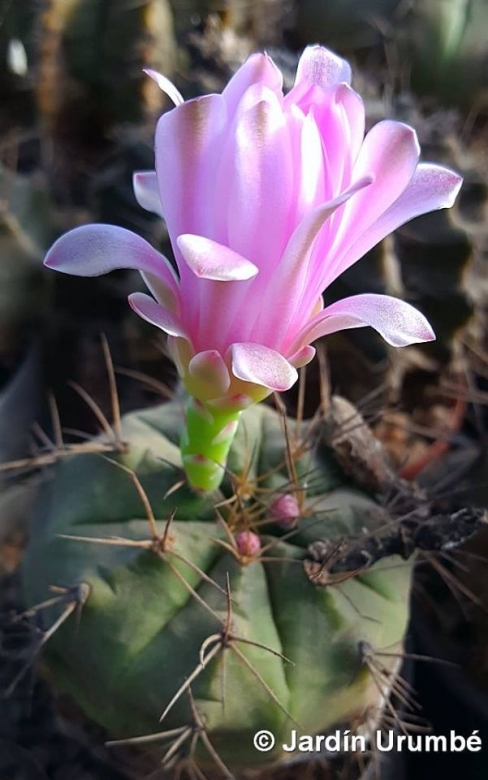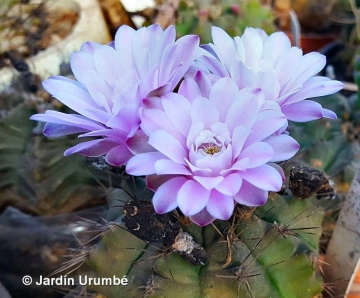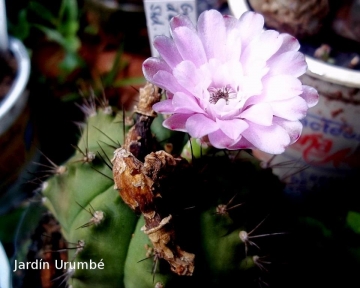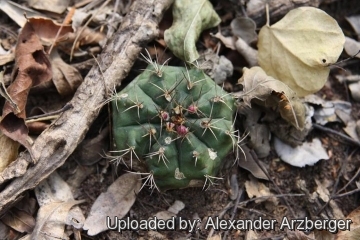Accepted Scientific Name: Gymnocalycium anisitsii (K.Schum.) Britton & Rose
Cactaceae (Britton & Rose) 3: 159, fig. 168. 1922 Britton & Rose

Gymnocalycium damsii var. boosii Photo by: Alexander Arzberger
Origin and Habitat: South-East of Chocis, Chiquitos Province, Santa Cruz Dept., Bolivia (Western South America, Southern America).
Altitude range: Around 300-600 metres above sea level.
Synonyms:
See all synonyms of Gymnocalycium anisitsii
Description: Gymnocalycium damsiiSN|13319]]SN|13319]] var. boosii (Gymnocalycium damsii ssp. evae var. boosi) is a local or morphological form of the widespread and variable Gymnocalycium damsiiSN|13319]]SN|13319]]. It has longer, thin, flexible and usually twisted spines sometimes up to 6 cm long that make the plant resembling a broom or a besom. The flowers are bright pink or carmine-red (red flowers are quite unique and seldom seen in Gymnocalycium damsiiSN|13319]]SN|13319]]). Seedlings are very nice, the bodies are a chalky pale green (as in Gymnocalycium Griseopallidum in his youth), and the ribs are banded whit lilac brown markings across the areoles especially when young, and these sometimes have crossbands of lighter colours. However the distinguishing characteristics of var. boosii, appear to fall within the natural variation of Gymnocalycium damsiiSN|13319]]SN|13319]] and it should be synonymized with the latter.
Subspecies, varieties, forms and cultivars of plants belonging to the Gymnocalycium anisitsii group
Gymnocalycium anisitsii is a very polymorphic species with a large range of variability. Two subspecies are recognized, the nominate form and subsp. multiproliferum. There seems to be very little justification for vars. centrispinum, rotundulum, torulosum and tucavocense. Gymnocalycium griseopallidum from the salt-pan desert area on the Bolivia-Paraguay borders may well be another variety or local form which has become adapted to the peculiar local conditions of that region.
 Gymnocalycium anisitsii (K.Schum.) Britton & Rose: may be solitary or freely offsetting with white flowers. Spines 5 to 7, tortuous, up to 6 cm. long. It is a very polymorphic species with a large range of variability. Distribution: Bolivia, Paraguay.
Gymnocalycium anisitsii (K.Schum.) Britton & Rose: may be solitary or freely offsetting with white flowers. Spines 5 to 7, tortuous, up to 6 cm. long. It is a very polymorphic species with a large range of variability. Distribution: Bolivia, Paraguay. Gymnocalycium anisitsii subs. damsii (K.Schum.) G.J.Charles: has stems to 10 cm tall, 8-15 cm in diameter, green to brownish-green, often with horizontal strips. Ribs broad to acute, and more or less notched. Distribution: Bolivia, Paraguay and Brazil.
Gymnocalycium anisitsii subs. damsii (K.Schum.) G.J.Charles: has stems to 10 cm tall, 8-15 cm in diameter, green to brownish-green, often with horizontal strips. Ribs broad to acute, and more or less notched. Distribution: Bolivia, Paraguay and Brazil. Gymnocalycium anisitsii subs. damsii f. cristatum hort.: crested form. Various clones. Garden origin.
Gymnocalycium anisitsii subs. damsii f. cristatum hort.: crested form. Various clones. Garden origin. Gymnocalycium anisitsii subs. damsii f. monstruosum hort.: monstrous form. Various clones. Garden origin.
Gymnocalycium anisitsii subs. damsii f. monstruosum hort.: monstrous form. Various clones. Garden origin. Gymnocalycium anisitsii subs. damsii f. variegata hort.: variegated form. Various clones. Garden origin.
Gymnocalycium anisitsii subs. damsii f. variegata hort.: variegated form. Various clones. Garden origin. Gymnocalycium anisitsii var. griseopallidum H.Till & Amerh.: has paler greyish-green, sharply ribbed stem and greenish-white flowers. Distribution: Santa Cruz (Salinas de San Jose, Cordillera ) Bolivia.
Gymnocalycium anisitsii var. griseopallidum H.Till & Amerh.: has paler greyish-green, sharply ribbed stem and greenish-white flowers. Distribution: Santa Cruz (Salinas de San Jose, Cordillera ) Bolivia.- Gymnocalycium anisitsii subs. holdii Amerh.
 Gymnocalycium anisitsii subs. multiproliferum (P.J.Braun) P.J.Braun & Esteves: has numerous violet-green stems, longer spines, and rose-colored flowers. Distribution Mato Grosso do Sul, Brazil.
Gymnocalycium anisitsii subs. multiproliferum (P.J.Braun) P.J.Braun & Esteves: has numerous violet-green stems, longer spines, and rose-colored flowers. Distribution Mato Grosso do Sul, Brazil. Gymnocalycium anisitsii var. tucavocense Backeb. ex H.Till & Amerh.: has beautiful deep mauve to violet flowers, is remarkably prolific in branching and very precocious flowering.
Gymnocalycium anisitsii var. tucavocense Backeb. ex H.Till & Amerh.: has beautiful deep mauve to violet flowers, is remarkably prolific in branching and very precocious flowering. Gymnocalycium anisitsii var. tucavocense cv. Red Form: it is a garden selection characterized by an unusual bright red colouring of the body, this colour is due to a reduced production of chlorophyll pigments.
Gymnocalycium anisitsii var. tucavocense cv. Red Form: it is a garden selection characterized by an unusual bright red colouring of the body, this colour is due to a reduced production of chlorophyll pigments.- Gymnocalycium anisitsii subs. volkeri Amerh.
 Gymnocalycium damsii var. boosii Amerh.: has longer, thin, flexible usually twisted spines up to 6 cm long. Flowers bright pink or carmine-red. Distribution: S-E of Chocis, Santa Cruz, Bolivia.
Gymnocalycium damsii var. boosii Amerh.: has longer, thin, flexible usually twisted spines up to 6 cm long. Flowers bright pink or carmine-red. Distribution: S-E of Chocis, Santa Cruz, Bolivia. Gymnocalycium damsii var. centrispinum Backeb.: has 7 radial spines and one long needle-like central spine to 2 cm long. The flowers are white. Distribution: Bolivia, in the vicinity of Roboré.
Gymnocalycium damsii var. centrispinum Backeb.: has 7 radial spines and one long needle-like central spine to 2 cm long. The flowers are white. Distribution: Bolivia, in the vicinity of Roboré.- Gymnocalycium damsii subs. evae Halda, Horáček & Milt
 Gymnocalycium damsii var. rotundulum Backeb.: it is characterized by rounder and scarcely raised tubercles. Distribution: Bolivia, Brazil & Paraguay.
Gymnocalycium damsii var. rotundulum Backeb.: it is characterized by rounder and scarcely raised tubercles. Distribution: Bolivia, Brazil & Paraguay.- Gymnocalycium damsii var. torulosum Backeb.
 Gymnocalycium damsii cv. Purple Blush: has purple blushed stems and nice pink blooms. It seems related to Gymnocalycium damsii var. tucavocense to which it shares many characteristics.
Gymnocalycium damsii cv. Purple Blush: has purple blushed stems and nice pink blooms. It seems related to Gymnocalycium damsii var. tucavocense to which it shares many characteristics.
Bibliography: Major references and further lectures
1) Gymnocalycium damsii (K. Sch.) Br. & R. in: http://www.carciton.cz/kaktusy/clanky11_3.htm
 - Seedlings: the first flower. Photo by: Alexander Arzberger
- Seedlings: the first flower. Photo by: Alexander Arzberger Gymnocalycium damsii var. boosii Photo by: Alexander Arzberger
Gymnocalycium damsii var. boosii Photo by: Alexander Arzberger Gymnocalycium damsii var. boosii Photo by: Alexander Arzberger
Gymnocalycium damsii var. boosii Photo by: Alexander Arzberger Gymnocalycium damsii var. boosii, AA 237, E Chochis, Dep. Sta. Cruz, Bolivia, 578m. Photo by: Alexander Arzberger
Gymnocalycium damsii var. boosii, AA 237, E Chochis, Dep. Sta. Cruz, Bolivia, 578m. Photo by: Alexander ArzbergerCultivation and Propagation: Gymnocalycium damsiiSN|13319]]SN|13319]] var. boosii is a summer grower species that is easy to cultivate.
Growth rate: It is a relatively rapidly growing and easily flowering species that will make clumps given the best conditions.
Soils: It likes very porous standard cactus mix soil. Prefer a low pH compost, avoid substrata rich in limestone; otherwise growth will stop altogether.
Repotting: This plant needs plenty of space for its roots, repotting should be done every other year or when the it has outgrown its pot. Use pot with good drainage.
Watering: Needs moderate to copious waterings in summer, but do not overwater (Rot prone), keep dry in winter at a minimum temperature of 0°C.
Fertilization: Feed with a high potassium fertilizer in summer.
Hardiness: Reputedly resistant to frost if kept on the dry side prior to, and during, cold weather (hardy to -5° C, or less for short periods).
Exposition: The plant tolerates extremely bright situations but enjoys filtered sunlight or afternoon shade, inside it needs bright light, and some direct sun. Tends to bronze in strong light, which encourages flowering and heavy spine production, but is likely to suffer from sun scorch or stunted growth if over exposed to direct sunlight during the hottest part of the day in summer.
Uses: It is an excellent plant for container growing. It always looks good and stays small. It look fine in a cold greenhouse and frame or outdoor in a rockery.
Propagation: Division, direct sow after last frost. Seeds germinate in 7-14 days at 21-27° C in spring, remove gradually the glass cover as soon the plants will be well rooted (ca 1-2 weeks) and keep ventilated, no full sun for young plants! To make a cutting twist off a branch and permit it to dry out a couple of weeks, lay it on the soil and insert the stem end partially into the soil. Try to keep the cutting somewhat upright so that the roots are able to grow downward.















